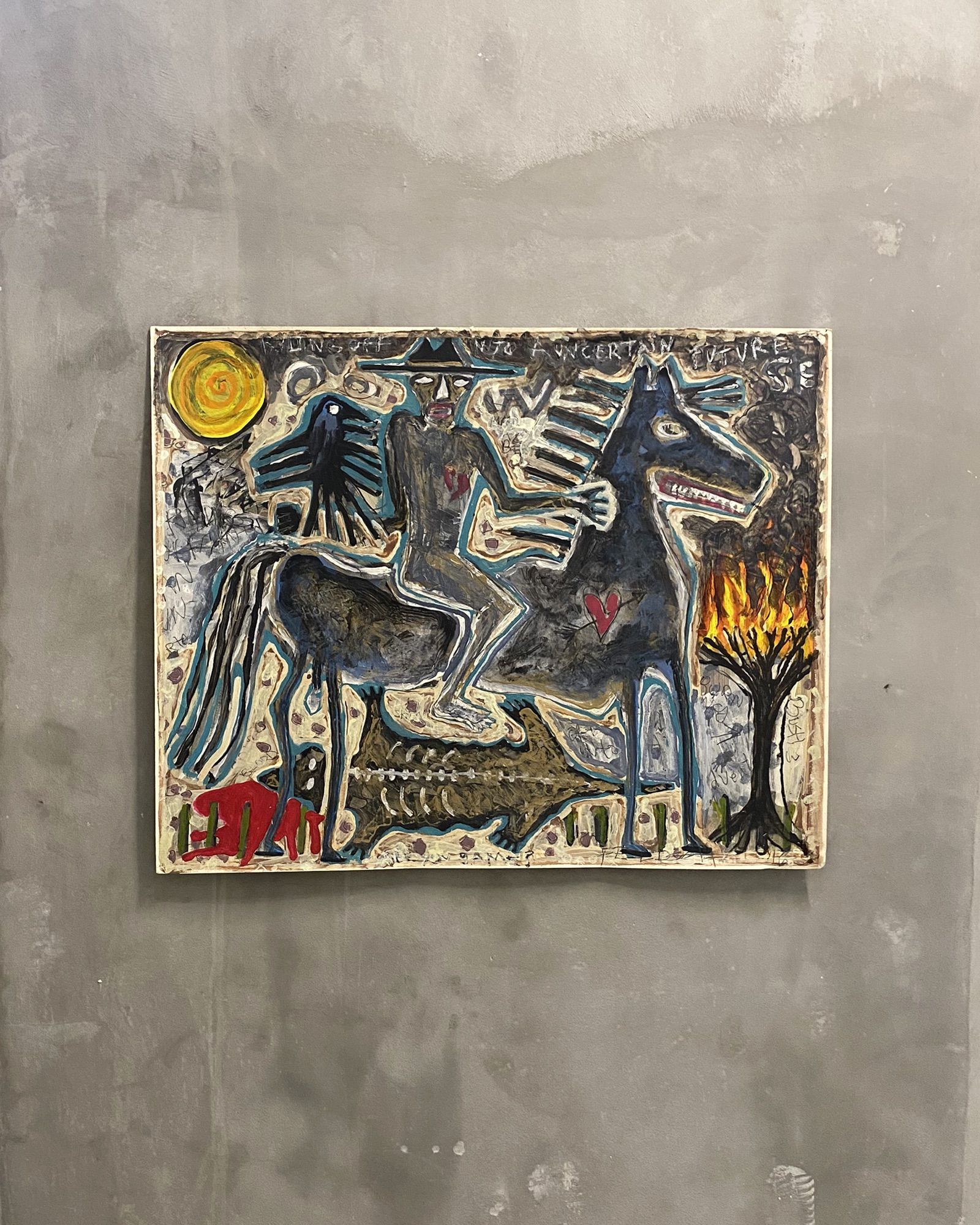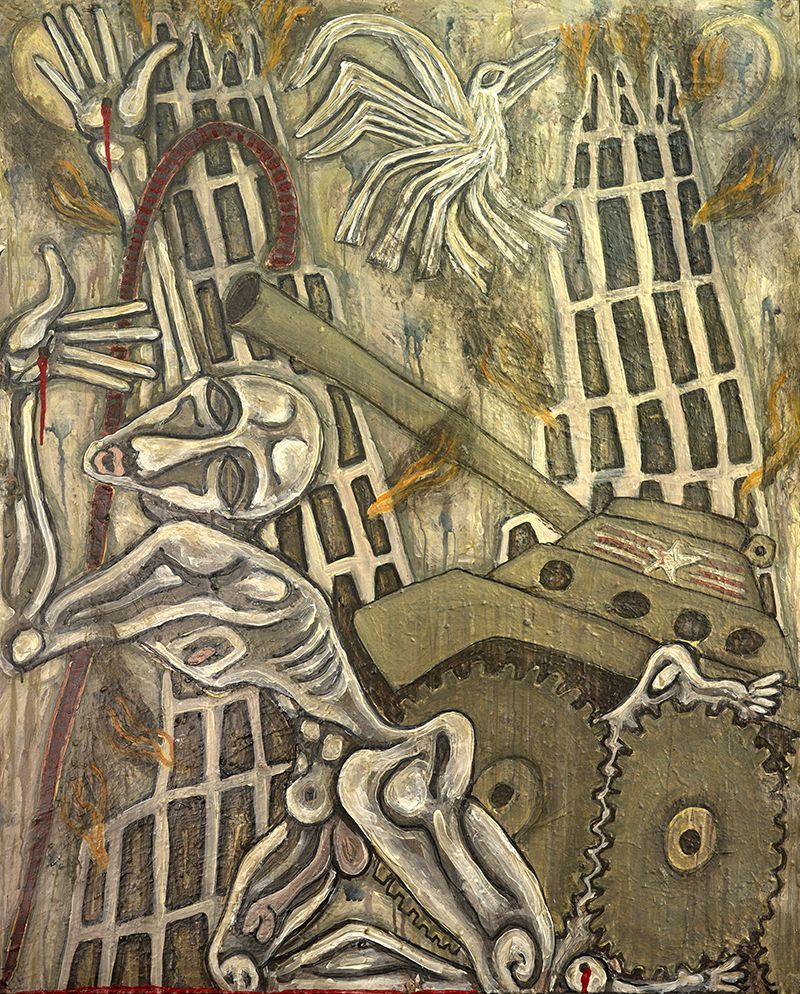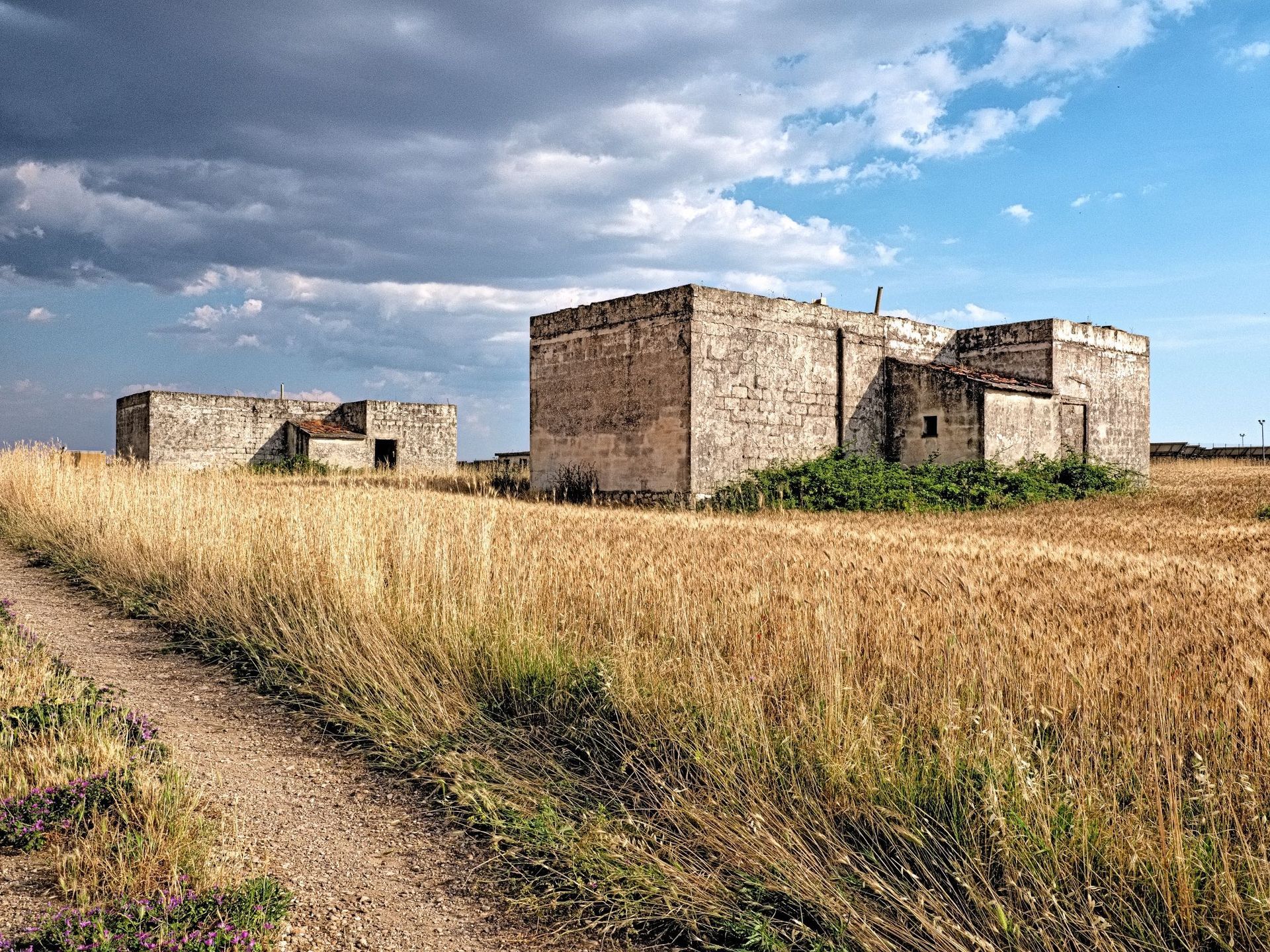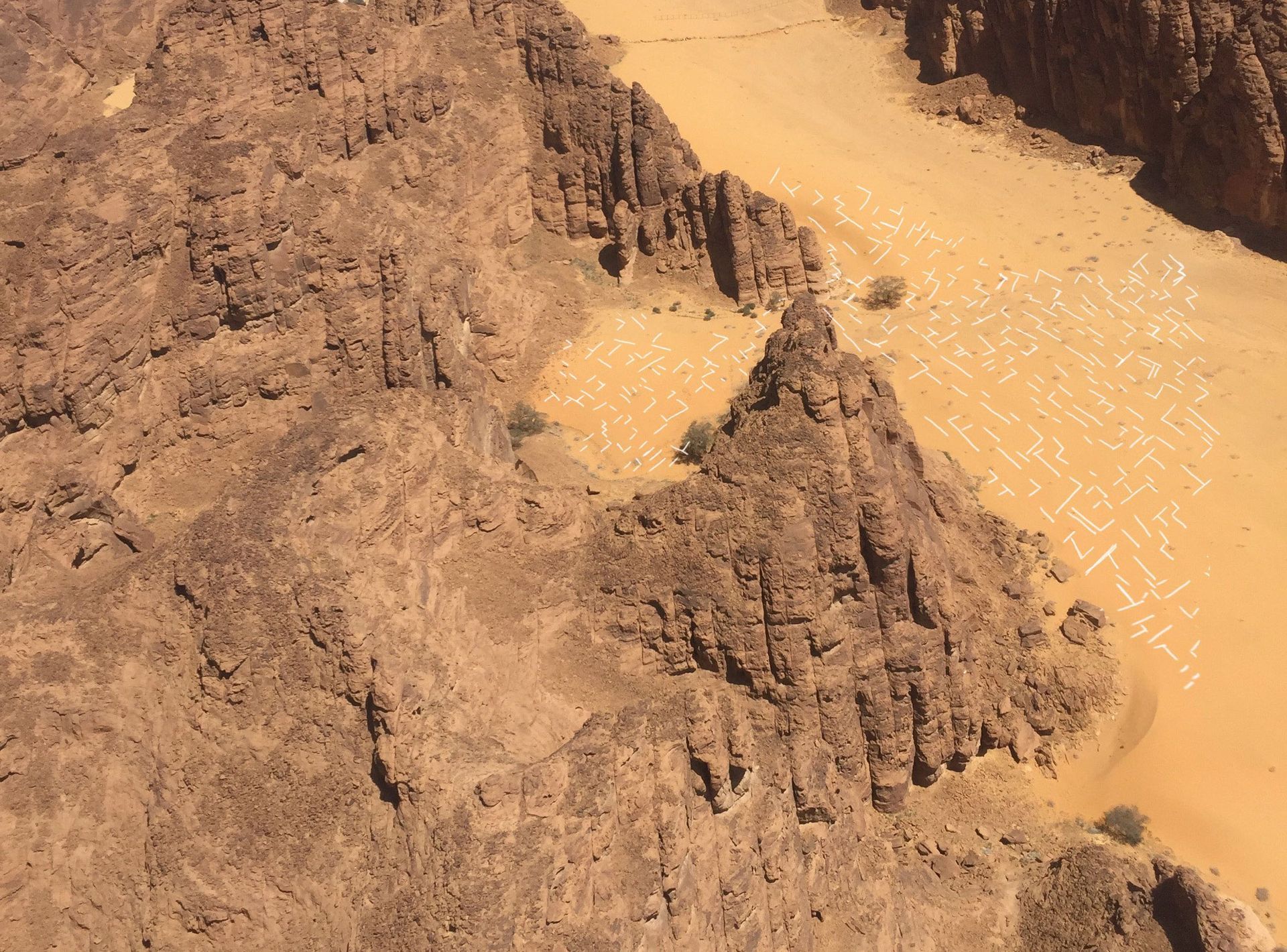
Courtesy Wienholt Projects
Feldsott: "How do we bridge our ancestry, where is that ancestry, and who were those people."
Feldsott is a US artist and healer living in California. His extraordinary work combines healing and painting. The title of his latest exhibition, which was shown during Frieze Los Angeles, is "My Responsibility". Feldsott's works seem to search for primal energy - neo-expressionism is mixed with shamanic elements. Feldsott's paintings repeatedly allude to various spiritual, political and ecological movements and atrocities, such as Abu Ghraib and Burning Monk. In some works, the handmade colours are thickly applied and interspersed with human hair, plant matter and medical elements. He also works with crushed alabaster or incorporates medical elements into his work, elements with which the artist wants to show empathy. However, "My Responsibility" mainly shows softer subjects. For Feldsott, everyone has a responsibility to confront disruption and unrest in the world in their own way in order to make a contribution, to "roll up their sleeves", so to speak.
Feldsott had early success in the art world. When he was still enrolled in the graduate programme at the California College of the Arts, his work was included in two exhibitions at the San Francisco Museum of Modern Art. In the 1980s, however, he turned away from art to learn shamanistic practices, which were already influencing his art. He was also disillusioned with the mechanisms of the art world; politics, business and the influence of money seemed insurmountable to him.
He spent the next few decades in the western Amazon region of Ecuador, where he trained as a traditional healer with indigenous groups. In addition to his painting, Feldsott now runs a healing practice in their community with his partner Dee.
24. March 2024
ART
Name: Feldsott
Education: School of the Art Institute of Chicago
California College of the Arts
Residence: California
What is behind the title of your latest exhibition My Responsibility? Is it a retrospective or have you also created new works for this exhibition?
The exhibition was chosen from the archives of my work going back into the 70s and up to the present with a recent painting from this year. The title of My Responsibility comes from a small drawing that I did in the early 90s. It was a drawing I made while I was thinking about the various levels and spheres of thought when somebody says, “That’s my responsibility.” When you start to think about that, it’s almost holographic in its implications. The curators and I felt that that was an interesting way to look at my trajectory as an artist over five decades.
What is the main focus of your artistic work today?
The focus of my work has remained pretty consistent over the last five decades and has always been a very conscious and intentional investigation into the wellspring of our primordial existence. In other words, investigating where we come from. When I say that I mean it in many applications in terms of our genealogy, DNA and in terms of our relationship to spirit and the world around us and so on. How do we bridge our ancestry, where is that ancestry, and who were those people? I believe that the remnants of everything that came before still percolates and exists in us in a very current and contemporary way. And if we facilitate a kind of intentional turning inward, the entire spectrum of that lineage is exposed. My work has always been an investigation into that river.
"For me, the act of healing works along very similar lines in that it is an attempt to kind of create some harmonic connection between spirit, energetic waves and the physical aspects of our being."
How are healing and painting connected for you?
I believe that the initial motivations and functions of art were an attempt to transmute the energetics of everyday reality with more spiritual energies and this is what gave birth to what we refer to as art-making. For me, the act of healing works along very similar lines in that it is an attempt to kind of create some harmonic connection between spirit, energetic waves and the physical aspects of our being. When those things are in harmony, we tend to refer to this as health. So most healers and most traditions of healing, on some level, using different techniques and different pathways, are attempting to do that, and I believe that art, on a fundamental level, is trying to do that as well.

Feldsott, Riding Off Into An Uncertain 2017, Courtesy Wienholt Projects
I have read about your decision to stop exhibiting and selling your work sometime in the 80s. What contributed to this decision?
When I was younger, I became disillusioned with the mechanics of the art world: the politics, the business, the influence of money, all of which was shaping certain kinds of aesthetics and opinions in ways that we then viewed and understood artwork. As a young man, that was frustrating to me and seemed insurmountable.
In hindsight, I believe it's simply just another aspect of something that we all deal with on one level or another almost every day. But as a young man, I arrived at a place where it felt impossible to continue to make and show art and somehow liberate it from these forces, so I decided to withdraw and continue to paint and make art but not offer it for exhibition nor offer it for any kind of sale or exchange of some sort. In doing so, I thought I had bypassed these ingrained institutional ways of going about the business and ingestion of art. As I got older, more mature, with a wider view of the world and able to live in a world that was more nuanced as opposed to these binary black-and-white kinds of states—I think I saw another way to participate in the art world and its ongoing dialogue and offer my work for whatever value people might find in it, and, for myself, remain peaceful and balanced in the transaction.
You also spent a lot of time in the rainforests of the Amazon?
I spent an extensive amount of time in the Amazon basin amongst Indigenous communities. My original reason for being there had to do with an inspiration and a calling to participate in environmental rehabilitation work and restoration and things of that nature. I understood there was a tremendous amount of environmental degradation happening in the region, and I felt called to participate and to somehow be helpful. As I began to participate and work with various communities creating certain kinds of projects that were aligned with these kinds of visions, I started to also see that there were deficiencies in myself and certain kinds of wounds and an inner lack of understanding within myself. Ultimately, I felt a little bit incomplete. I felt energetically called and drawn to the deeper wisdom traditions within these communities and the ways in which they were seeing and interacting with the world. I became aware of certain healing traditions that existed in that area, and people were very generous and kind to introduce me into these healing traditions, which helped me make some significant progress in my own personal journey of trying to restore my health and my overall balance.
A book of Japanese poetry in your early artistic days is said to have set you on a new path. Can you tell us more about this moment and are there others that have laid out new paths for you and your work?
When I was younger, I spent the early part of my adulthood in a pretty hard place. I came across an old book of Japanese poetry that struck me in that particular moment because of what was kind of behind the poetry. There was an indication of some deeper way of moving through the world that I felt was, at that moment of my life, incredibly inspirational. And that did set me on a journey to discover who these people were and how they trained, how they cultivated, how they functioned, hoping to maybe have some of that knowledge rub off on me a little bit, set me a little bit more straight. That was one of those magical moments in one's life.
Beyond that (and I don't know about books) but most of the writings and attitudes that would inspire me were derived from the Beat poets who were a generation ahead of me. In fact, one of my first exhibitions was in this space in the Bay Area in the 70s where all these great Beat poets would gather and I actually brought in all this construction debris that visitors had to walk over to get to the art, and it feels as though My Responsibility has a similar vibration to it with how its presenting the work in a raw, concrete space. So it feels a bit full circle. I was profoundly impacted by the work of these kinds of poets, their process, courage, boldness—all of that was very, very inspirational to me as a young artist.
It seems like a lot of vulnerability is needed to be an artist, at least an artist such as yourself. Do you find this to be true?
It's hard to speak for artists or art in general. These are huge questions and maybe a little bit over my pay grade. For me personally, I think my work is honest, unfiltered, unedited, it's whatever moves through me. There's a great deal of vulnerability involved because there's a sense of exposure, but I trust the process. I believe that vulnerability is itself a process. I believe that for myself, maybe for others as well, to become more transparent and more vulnerable is what will maybe make the world a little more peaceful.
" When it is at its best, it is an honest exploration through the internal channels in my own system."
Looking back, how has your time traveling outside the United States influenced your art?
I did have a very large show of my work at the Museum Guayasamin in Quito, Ecuador, in the early 2000s. They had a major show there of maybe 30 or 35 paintings, which was very significant to me.
It's such an interesting question because people want to see that somehow my time spent outside of the United States and amongst Indigenous people has shaped who I am, and of course that part is true. And yet, what I spoke about earlier has always been the focus of my work, whether I could have articulated it back in the 70s or not, I don't know, I don't think so. But it's clear to me at this point in my life, being a 70-year-old artist, that the work has always been an investigation into the deeper primordial origins of who we are. We can all trace our ancestry back to the original groups of hunters and gatherers that populated the world 10,000 or more years ago.
Anybody who conducts that investigation and starts to look at lineage within themselves is going to find some of these primordial energetics and those are not unique to some specific culture, they are actually the heritage of all of us. So, no, the work is not particularly influenced by any particular culture or people or tradition. When it is at its best, it is an honest exploration through the internal channels in my own system.

Feldsott, Praying Man ©Feldsott
TOP STORIES
ISRAEL
Düsseldorf commemorates the destroyed Great Synagogue in difficult times. Presentation "missing link_" by Mischa Kuball
November 2023
_____________
LUXURY
US high-end furnishing giant RH The Gallery opens in Düsseldorf with star guests.
November 2023
_____________
ENGLISH CHRISTMAS
10 years of Glow Wild at Kew Wakehurst.
October 2023
_____________
TRIENNALE MILANO
Pierpaolo Piccioli explains his fascination with art.
_____________
NEW MUSEUMS
29 May 2023
_____________
NEW MUSEUMS
The Deutsches Fotoinstitut
is coming in big steps.The Bernd and Hilla Becher Prize will be awarded for the first time.
19 May, 2023
_____________
VISIONS, ARCHITECTURE
MARCH 10, 2023
_____________
CHECK THE THINGS YOU WANT TO THROW AWAY
HA Schult's Trash People at the Circular Valley Forum in Wuppertal on 18 November 2022.
NOVEMBER 19, 2022
_____________
THE OPERA OF THE FUTURE
Düsseldorf, capital of North Rhine-Westphalia will receive the opera house of the future.
FEBRUARY 15, 2023
_____________
FLORENCE
The extraordinary museums of Florence in 2023.
JANUARY 1, 2023
_____________
DÜSSELDORF
DECEMBER 11, 2022
_____________
DISTANT WORLDS
Dieter Nuhr's paintings now in Senegal - "A Nomad in Eternal Transit"
RELATED TALKS






